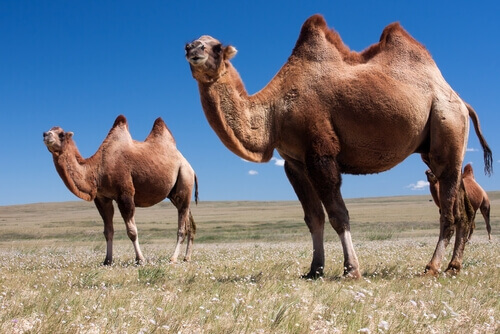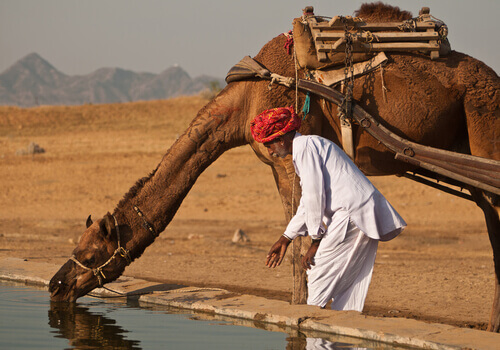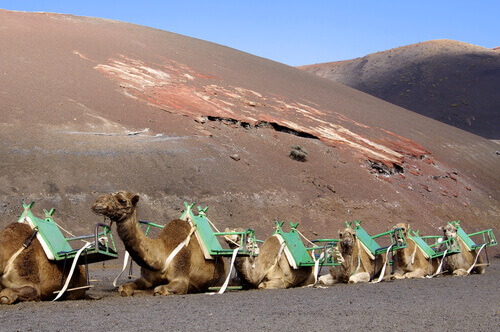The Curious Feeding Habits of Camels


Written and verified by the lawyer Francisco María García
Camels are generally herbivores. Their diets contain salt so they usually eat grass and salty desert plants. However, during times of famine, they can consume all kinds of food. Let’s take a closer look at the curious feeding habits of camels.
These animals can eat all kinds of plants and vegetation, even in the most inhospitable terrain. For example, they can eat dry branches and leaves, weeds, seeds, grains, herbs, and fresh or dried fruits.
Feeding habits of camels: Storing food
Camels can store food in their humps to use when they don’t have food within reach. In fact, they can store up to 80 pounds of fat! Remember, many of these animals live in deserts or similar environments. As a result, food isn’t always available. Due to their environments, they have adapted to be able to go up to two weeks without eating.

Lips and digestive system
One of the reasons camels can eat all kinds of plants, even prickly ones, is because of their lips. With their lips, they’re able to eat plants of various different textures, regardless of whether they are hard, soft, dry, or wet.
Also, their digestive systems help them make the most of every food they eat, even if they can only eat sporadically. The mechanism of their stomachs digests food several times. This is thanks to a system of three chambers that allow them to digest food multiple times.
These animals’ bodies can also absorb moisture from the vegetation they eat. This gives them a good dose of extra water, which they can also store.
Feeding habits of camels: Their humps
As we mentioned, camels’ humps act almost like a pantry of solid product and water. As they accumulate fat in their humps from what they eat, their humps actually increase in size. This is also true of water.
As time passes, the reverse occurs. In other words, as the camels use the nutrients from their humps, they decrease in size. In fact, sometimes if the animal has used up all available fat in their humps, the skin on their hump can fall loose to one side.

Although camels don’t need to drink continuously, or even once a day, they drink plenty of fluid when they can. In fact, experts say that camels can drink up to 75 liters of water at once.
Camels’ diet
As we’ve seen, many camel populations live in inhospitable places, full of sand dunes, and arid terrain. In fact, these are places where very few animals can survive. Camels, because of their special characteristics, are able to thrive in the desert.
The normal diet of camels is based on dry plants, cacti, roots, and thorny branches. Camels can eat plants that other animals can’t. Among other things, this is because they have adapted to vegetables with high salt content.
What about water? In the absence of fresh drinking water, camels can drink whatever saltwater they find, whether from small lakes or ponds. In fact, there are ponds that have such high salt concentration – even higher than the ocean – that no other animal could drink from them.
However, if camels can’t find food or water, they have the ability to travel long distances in search of food and water. In fact, their sense of direction is ideal.

In the case of domestic camels, their diet is usually based on leaves, plants, cereal, corn, wheat, and oats. However, some owners have found that their favorite foods are dates.
Bactrian camel
The Bactrian camel, generally known simply as a camel, is native to East Asia, specifically China and Mongolia. They have two humps and are smaller and more robust than other camels. Currently, there are around 1.4 million Bactrian camels.
Contrary to the association of camels with high temperatures, this species actually has long hair to protect themselves from Asian winters. They tolerate extreme weather conditions. For example, they can handle temperatures up to 104 degrees Fahrenheit in the summer and -22 degrees Fahrenheit in the winter. They are stronger than dromedaries and can carry more weight.
Threats to the Bactrian camel
The progressive destruction of the habitat of these camels is one of their main threats. In some parts of the world, such as China and Mongolia, mining and industrial activity have affected these specimens. As a result, these activities are decreasing the number of specimens. These conditions have made it more difficult for this camel to survive.
Humans are a camel’s main predator, and the tiger is their only other one. The average life span of camels is 40 to 50 years.
This text is provided for informational purposes only and does not replace consultation with a professional. If in doubt, consult your specialist.